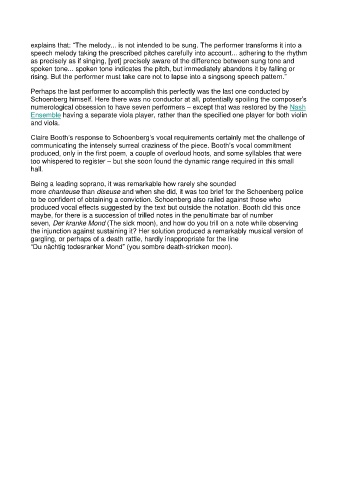Page 583 - Media Coverage Book - 75th Aldeburgh Festival 2024
P. 583
explains that: “The melody... is not intended to be sung. The performer transforms it into a
speech melody taking the prescribed pitches carefully into account... adhering to the rhythm
as precisely as if singing, [yet] precisely aware of the difference between sung tone and
spoken tone... spoken tone indicates the pitch, but immediately abandons it by falling or
rising. But the performer must take care not to lapse into a singsong speech pattern.”
Perhaps the last performer to accomplish this perfectly was the last one conducted by
Schoenberg himself. Here there was no conductor at all, potentially spoiling the composer’s
numerological obsession to have seven performers – except that was restored by the Nash
Ensemble having a separate viola player, rather than the specified one player for both violin
and viola.
Claire Booth’s response to Schoenberg’s vocal requirements certainly met the challenge of
communicating the intensely surreal craziness of the piece. Booth’s vocal commitment
produced, only in the first poem, a couple of overloud hoots, and some syllables that were
too whispered to register – but she soon found the dynamic range required in this small
hall.
Being a leading soprano, it was remarkable how rarely she sounded
more chanteuse than diseuse and when she did, it was too brief for the Schoenberg police
to be confident of obtaining a conviction. Schoenberg also railed against those who
produced vocal effects suggested by the text but outside the notation. Booth did this once
maybe, for there is a succession of trilled notes in the penultimate bar of number
seven, Der kranke Mond (The sick moon), and how do you trill on a note while observing
the injunction against sustaining it? Her solution produced a remarkably musical version of
gargling, or perhaps of a death rattle, hardly inappropriate for the line
“Du nächtig todesranker Mond” (you sombre death-stricken moon).

